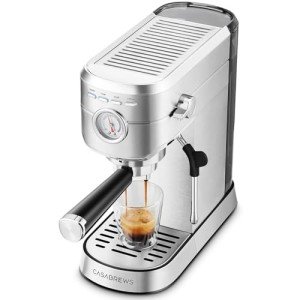The Rise of Black Espresso Machines: Features, Benefits, and Recommendations
Espresso machines have become a necessary device in lots of homes and cafés, progressing from a specialty item to a basic cooking area component. Among the different color options and styles available, black espresso machines are leading the pack in regards to visual appeals, adaptability, and consumer choice. In this post, we look into the factors behind their appeal, the features that set these machines apart, and handy pointers for picking the ideal black espresso machine for your home.
The Appeal of Black Espresso Machines
Visual Versatility
Black espresso machines effortlessly blend into any kitchen design. Whether your kitchen area boasts modern, minimalist styles or conventional, relaxing visual appeals, a black espresso machine matches the environment without encountering other devices. The sleek surface contributes to a refined look, adding a touch of beauty to your countertop.
Easier Maintenance
Unlike lighter-colored machines that might show spots, smudges, and water areas more easily, black espresso machines tend to withstand noticeable wear and tear. This not just makes them more aesthetically appealing with time but likewise lowers the frequency of cleansing required.
Broad Market Availability
The appeal of black espresso machines has resulted in a wider variety of designs, features, and price points. Consumers have the advantage of selecting from compact home machines to commercial-grade systems, guaranteeing that there is something for everyone.
Key Features to Consider
When searching for a black espresso machine, it is vital to think about numerous functions that affect performance and ease of use. Below are a few of the most essential features to look for:
1. Kind Of Espresso Machine
There are several types of espresso machines that cater to various skill levels:
- Manual: Requires the user to have exact abilities and is perfect for enthusiasts looking for complete control over the espresso-making procedure.
- Semi-Automatic: Offers a balance between control and benefit. Users can manage the extraction time however take advantage of the machine's automatic pressure policy.
- Automatic: Takes care of the water dose, making it best for those who want consistent results with minimal effort.
- Super-Automatic: The most easy to use type, these machines grind beans, tamp coffee, and brew the espresso with just the push of a button.
2. Construction Material
Quality building products, such as stainless-steel or state-of-the-art plastic, make sure resilience and performance. Machines with all-metal bodies typically have much better durability and aesthetic appeal.
3. Size and Capacity
Before purchasing, think about kitchen area area and the machine's capability. If you're amusing regularly or serve espresso to numerous visitors, larger water tanks and bean hoppers are beneficial.
4. Ease of Use and Features
Try to find functions that boost the user experience:
- Programmable Settings: enables customization of your developing process.
- Steam Wand: essential for frothing milk for coffees and lattes.
- Integrated Grinder: lowers the requirement for additional devices and uses fresh premises.
- Water Filtration System: boosts water quality, affecting the taste of the espresso.
5. Price Range
Rates for black espresso machines can differ extensively. Budget designs might range from ₤ 100 to ₤ 300, while mid-range machines fall between ₤ 300 and ₤ 800. For commercial-grade or advanced super-automatic machines, expect to invest ₤ 800 and up.
Table: Price Range of Black Espresso Machines
| Type of Machine | Cost Range | Key Features |
|---|---|---|
| Budget Manual | ₤ 100 - ₤ 300 | Standard functionality, manual operation |
| Mid-Range Semi-Automatic | ₤ 300 - ₤ 800 | Programmable settings, steam wand |
| Super-Automatic | ₤ 800 and up | Full automation, built-in grinder |
| Commercial Grade | ₤ 1,000 and above | High capacity, durable building and construction |
Benefits of Owning a Black Espresso Machine
1. Quality of Espresso
The main function of an espresso machine is to brew high-quality espresso. An excellent black espresso machine can use rich tastes and an aromatic experience.
2. Cost-efficient
Investing in an espresso machine allows users to create café-quality drinks in the house, conserving money in the long run.
3. Convenience
Enjoying fresh espresso from the convenience of home minimizes trips to cafe, providing convenience especially for hectic people.
4. Customization
Home baristas can explore different coffee beans, grind settings, and temperature levels to find their ideal cup.
Often Asked Questions (FAQs)
Q1: What are the very best black espresso machines on the market?
Some top-rated black espresso machines consist of the Breville Barista Express, De'Longhi Magnifica, and Rancilio Silvia, each offering a balance of quality and usability.
Q2: How do I preserve my black espresso machine?
Regular maintenance consists of cleaning up the machine after use, descaling every couple of months, and regularly inspecting and changing water filters.
Q3: Can I make beverages aside from espresso with these machines?
Yes, many espresso machines feature steam wands, enabling you to create cappuccinos, lattes, and other coffee drinks.
Q4: What size should I select for my kitchen?
Select a machine based upon your countertop area and the volume of coffee you normally brew, considering both water tank size and overall dimensions.
Q5: Are black espresso machines more pricey?
Not always; while some high-end designs are black, there are budget-friendly alternatives available in this color variety.
Black espresso machines are not simply a pattern; they embody performance, style, and flexibility. Whether you are a coffee lover or a casual drinker, these machines use something for everyone. By carefully thinking about functions, buying quality, and selecting the best type, coffee enthusiasts can enjoy the many advantages of developing espresso in your home in style. Espresso Machines Under £200 of black espresso machines will likely continue to grow, making them a staple in kitchens around the world.

